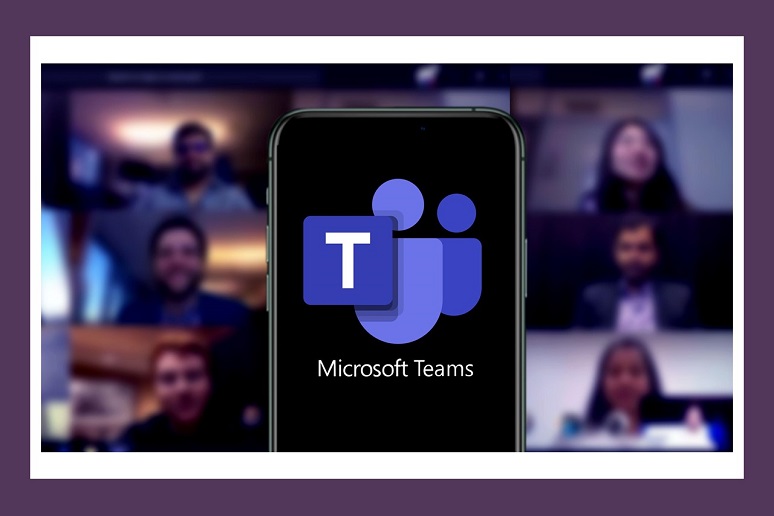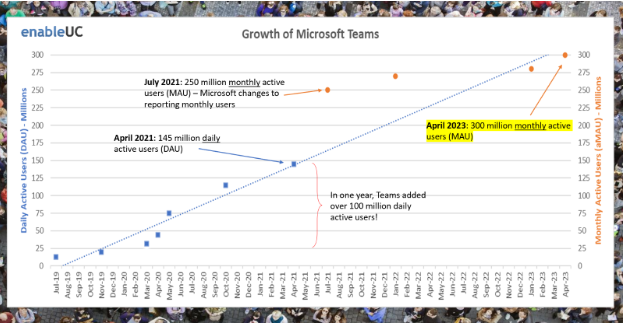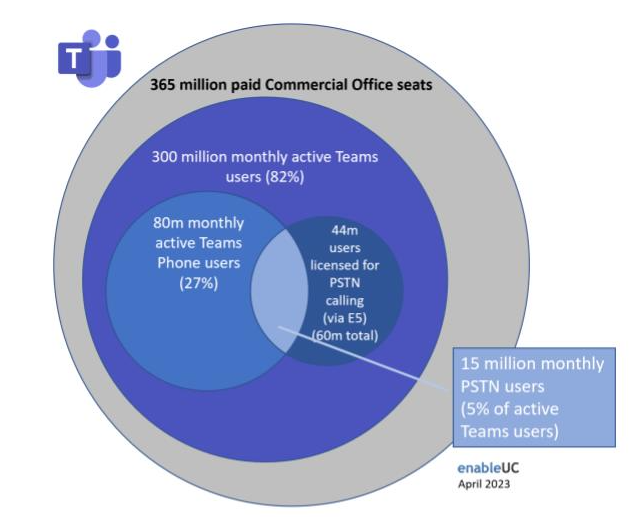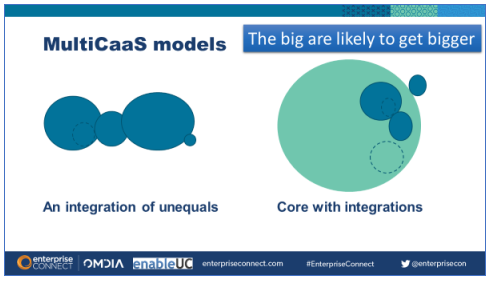According to an April 24, 2023 article in the Financial Times, Microsoft has agreed to “unbundle” Teams from the Office suite, allowing customers to purchase Office with or without Teams included.
While the article suggests that this deal is not finalized, it is unclear whether such a move would have any impact on the continued growth of Microsoft Teams.
Competitors may hope an unbundled Teams provides them with increased opportunities, but it is unlikely that the growth of Teams will slow. And, while it may seem that a “best of breed” approach could be fueled by Teams becoming a separately purchased application, “best of breed” has always been a theoretically good and practically bad concept. The rise of generative AI provides more incentive for organizations to purchase a complete productivity suite, even if they need to purchase it in multiple parts.
When contacted about the FT report, a Microsoft spokesperson provided this statement: “We are mindful of our responsibilities in the EU as a major technology company. We continue to engage cooperatively with the Commission in its investigation and are open to pragmatic solutions that address its concerns and serve customers well.”
Some have speculated that the offer to unbundle Teams from Office may be in response to competitor Slack’s attempt to have EU officials force Microsoft to sell Teams separately. (Salesforce purchased Slack for $27.7B in 2020.)
Teams Has Seen Rapid Growth
Officially launched just over 6 years ago at Enterprise Connect, Teams rapidly picked up users, especially during the period from March 2020 through May 2021 where Teams added over 100 million daily active users. This was driven by the pandemic, but that growth continues. On its April 25, 2023 earnings call, Microsoft reported Teams usage surpassed 300 million monthly active users in the quarter.
"Teams Is Free" as the Initial Pitch to Enterprise Customers
“Teams is free” was an initial core message encouraging organizations to try Teams. Indeed, Microsoft added Teams to every business license plan at no additional cost. Eventually Microsoft introduced a free version of Teams, creatively called “Microsoft Teams (free).” That messaging resonated, driving over 80% of commercial users to actively use Teams.
Once an organization was using Teams, it became reasonable to suggest considering Teams Phone as your voice system, even though for most organizations, this required purchasing additional licensing and arranging a PSTN connection (via Microsoft Calling Plans, Direct Routing, or Operator Connect from a variety of carriers).
While this is still an area of focus for Microsoft and its partners, the 5% of Teams users (~15 million) who are active PSTN users make Microsoft Teams the largest multi-tenant UCaaS telephony provider, according to research presented by Brent Kelly of Omdia at Enterprise Connect 2023 during the Living in the MultiCaaS: Comparing Microsoft, Cisco, Zoom, and RingCentral Solutions I co-presented with him. (No Jitter reported on that session.)
In addition, the number of Teams telephony users is expected to grow, as there are an additional 29 million users licensed for Teams Phone via their E5 licenses. That is, the 44 million licensed for PSTN calling (shown in the preceding Ven diagram) minus the 15 million monthly PSTN users. Growth may slow given the industry-wide reduction in PSTN calls with the uptick in scheduled meetings which use VoIP.
Integration as the Current Driver
While adding Teams to the Office/Microsoft 365 bundle initially drove adoption, Teams lived up to the stated vision to be “a hub where work gets done.” Now almost every application and device vendor has created a Teams integration.
This was abundantly clear during the Living in the MultiCaaS: Comparing Microsoft, Cisco, Zoom, and RingCentral Solutions session I co-presented with Brent Kelly. Cisco, RingCentral, and Zoom have all created integrations so they can operate directly within Teams. RingCentral provides certified Direct Routing (PSTN connectivity) for Teams, and Cisco has certified its most popular devices and its Webex contact center for Teams.
This is what the graphic illustrates – while statistics suggest that most organizations use two or more collaboration tools, increasingly it is Teams at the core. Put another way, Microsoft is not integrating Teams with those other platforms. Those platforms are integrating with Teams.
Even if unbundled, Teams will continue to have measurable value as a work hub. The rise of generative AI and the power of centralized data to fuel the large language models, multiplies the value of tying all telemetry into a “central/single source of truth,” such as that provided by the Microsoft Office Graph.
The Bundle is Finite
Arguably, few users are aware of breadth of apps already included in Office 365 (Delve, Kaizala, Customer Voice, Bookings, Lists, to name a few), so adding more applications and features to the Microsoft/Office 365 bundle does not drive additional revenue for Microsoft. What makes more sense is to create separate, function-specific bundles of different tools. For example, Microsoft created Viva, a completely new bundle focused on employee experience. A new bundle with incremental licensing costs, Viva brings together goals, communications, learning, workplace analytics, and employee feedback. And the new Viva Sales application extends the platform to specific job functions, helping sellers apply large language models to their CRM and Microsoft 365 data, so they can automatically generate content, like customer mails.
Most of the Viva functions are integrated with and surfaced through Teams. This further bolsters the value of Teams in that it now serves as a central integration point and work hub for many users.
Increasing Average Revenue Per User (ARPU)
With a strong position in Office Productivity applications, including a commanding position for corporate email, a leading collaboration tool in Teams, and the largest install base for multi-tenant UCaaS telephony, Microsoft is working hard to increase average revenue per user (ARPU). Last year, the company rolled out a commercial pricing increase for Microsoft 365 and introduced a $40 per room per month fee for Teams Room Pro (required for organizations with more than 25 rooms or those who want to use dual screens and other advanced features). In February this year, Microsoft announced a $10 per user per month Teams Premium license, which includes an eclectic mix of more advanced Teams features (discounted to $7/user/month through July 1, 2023), and there's a strong possibility that the new Copilot AI features to be incorporated into the Office application, including Teams, will likely require additional licensing, at an increased cost
How Unbundling Teams Could Help Microsoft
If Teams were unbundled from Office, it would allow Microsoft to ameliorate the confusing Teams standard versus Teams Premium licensing. Users could be charged an incremental fee, perhaps $3-$8 per user per month, for Teams inclusive of the Premium features, and potentially enabled with the soon-to-be-released Copilot AI features.
Six years ago, when Teams was introduced, Slack took out a full-page ad in the New York Times, which read in part, “Congratulations on today’s announcements. We’re genuinely excited to have some competition.”
Now, for those pushing Microsoft to unbundle Teams, the lesson potentially is “be careful what you wish for.”














